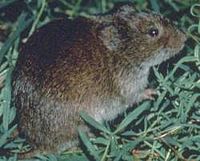
Photo from wikipedia
A characterization of long-term station and field studies (1958–2017) on the tiaga in northwestern Russia is given for the population-ecology features of reproduction of the bank vole, including those associated… Click to show full abstract
A characterization of long-term station and field studies (1958–2017) on the tiaga in northwestern Russia is given for the population-ecology features of reproduction of the bank vole, including those associated with its habitat at the northern borders of its distribution: reproductive cycles and the timing, course, and intensity of reproduction. According to the dates, including from the results of histological examination of the gonads, under the conditions of the northern periphery of its range, the bank vole has a long breeding period from April to September with the very intensive participation of young fertile voles, especially early spring–summer births. The male reproductive cycle has a stage of passive spermatogenesis with a rapid increase in the epithelium and the appearance of spermatocytes of both orders. From April, active spermatogenesis occurs, during which the epithelium of germinal becomes layered and mature spermatozoa appear in the tubules and appendages of the testis. Ovulation in females, apparently, is spontaneous, as is evidenced by cases of the presence of a false corpus luteum in adult (overwintered) females, as well as in newcomers, the reproduction of which is interrupted by seasonal depression. The average duration of the sexual cycle is 5–6 days; the maximum is about two weeks. In this article a function of population autoregulation, which depends on the initial population density of the adaptive shift involved in the reproduction of age-related generations of animals, is revealed.
Journal Title: Biology Bulletin
Year Published: 2020
Link to full text (if available)
Share on Social Media: Sign Up to like & get
recommendations!